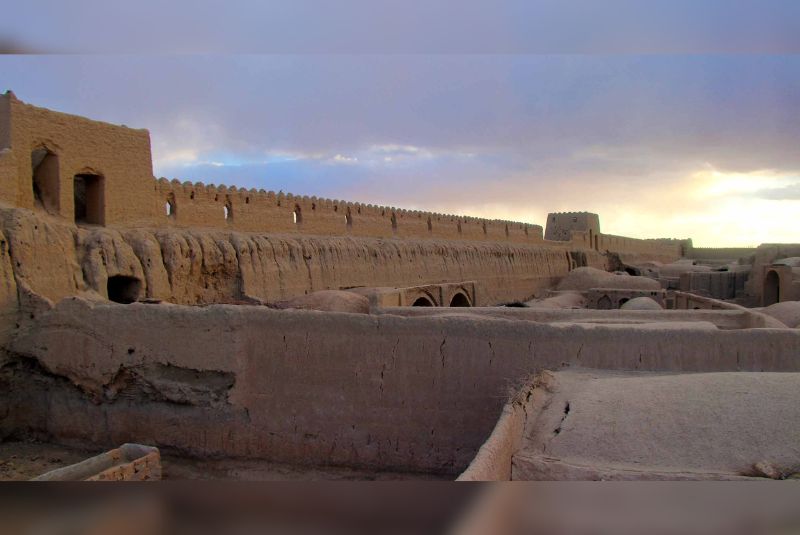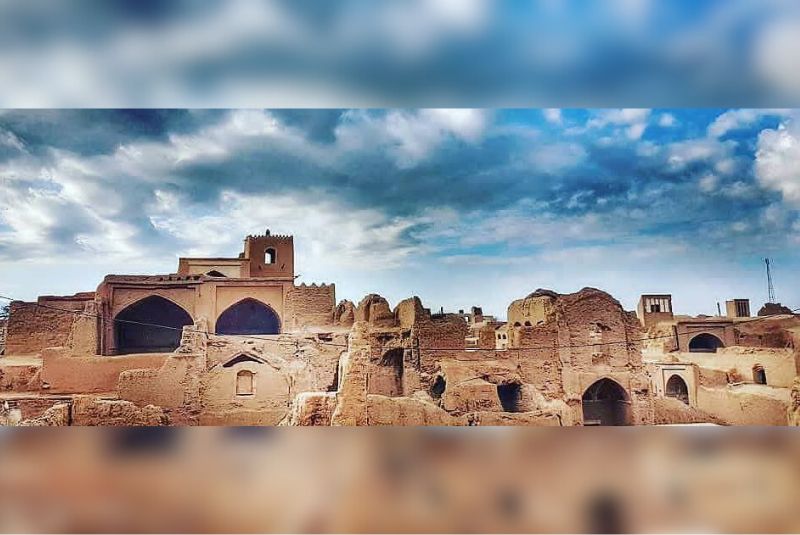Ghoortan Citadel | Desert Fortress of Legends
Located in the heart of Isfahan province, Iran, lies the historically significant Ghoortan Citadel, an architectural marvel resonating with tales of the past.
Dating back to the fourth century during the reign of Bahram V Sassanid, this fortress-cum-residential area serves as a testament to ancient craftsmanship and strategic planning. Situated approximately 90 kilometers from Isfahan city and just 10 kilometers off the road leading from Varzaneh city, the citadel stands as a symbol of resilience amidst the desert landscape.
What truly distinguishes Ghoortan Citadel is its unique architectural heritage—crafted entirely from clay and mud, an ingenious adaptation to the arid climate. The fortress encompasses an array of structures: mosques, forts, a market, and a bathhouse, each a fragment of a bygone era. Its fortified ramparts, standing 12 meters tall, encircle the complex, preserving remnants of a storied past.
The allure of Ghoortan Citadel lies not only in its physical grandeur but also in its cultural significance. It echoes with the whispers of a language known as Valati, spoken alongside Persian, underscoring its historical roots. Stepping within its walls is akin to traversing a time portal, inviting visitors to immerse themselves in a rich tapestry of history and heritage.
Historical Background of Ghoortan Citadel

The Ghoortan Citadel, tracing its origins to the illustrious Sassanid era, stands as a living testament to Iran's ancient architectural prowess and strategic fortifications. Its genesis dates back to the reign of Bahram V Sassanid in the fourth century, showcasing initial glimpses of what would evolve into a remarkable fortress. However, archaeological excavations have unveiled remnants from even earlier periods, hinting at an extensive settlement that possibly existed during the Achaemenid period, underscoring the site's antiquity and historical depth.
Across the centuries, the Ghoortan Citadel age has witnessed multiple phases of construction and inhabitants, each leaving an indelible mark on its character. As various rulers and dynasties held sway over the region, the citadel underwent expansions, renovations, and adaptations, shaping its formidable stature. It transitioned from a military stronghold to a residential haven, accommodating and safeguarding generations of families through uncertain times.

Significantly, the fortress played a pivotal role in defending its residents against external threats, embodying its importance as a defensive structure. Strategically positioned, the towering ramparts and fortified walls served as bulwarks shielding the inhabitants from incursions and providing sanctuary during tumultuous periods in history. Amidst regional instabilities, the citadel stood as a bastion of safety, its architecture reflecting the sophistication of defensive planning tailored to endure hostile environments.
The Ghoortan Citadel's legacy as a protective stronghold endures through the annals of time, resonating with the resilience and fortitude of its people. Its evolution from a bastion of defense to a living testament of history showcases the enduring spirit that characterizes this ancient citadel, drawing visitors into its rich narrative of survival and adaptation.
| Related: Most Beautiful and Historical Castles in Iran
Ghoortan Citadel Architecture

The architectural marvel of Ghoortan Citadel Varzaneh lies not just in its historical significance but also in the ingenious construction techniques employed within the desert landscape. Constructed entirely using locally sourced materials such as mud and clay, the citadel stands as a testament to ancient architectural brilliance, adapting to the arid climate of the region. This unique choice of building material allowed the citadel to withstand the harsh desert environment while showcasing remarkable structural integrity.
The layout of Ghoortan Citadel Varzaneh is a testament to meticulous planning and skilled craftsmanship. Its fortified ramparts, towering at a remarkable height of 12 meters, encircle the complex, symbolizing strength and defense. The citadel features distinct gates, including the north and south gates, each adorned with a spacious vestibule, offering a glimpse into the architectural grandeur of the era.

Within the confines of the citadel, one can explore various significant structures that reflect the diverse facets of daily life and communal activities. Mosques, including Ahleh Mosque with its unique architecture, Bala Masjid dating back to the early Islamic period, and the intricately designed Ibrahim Mosque, stand as sacred relics, showcasing the spiritual essence of the citadel's inhabitants.
The marketplace, a bustling center of trade in bygone eras, now stands as ruins, echoing the once vibrant commercial activities within the walls. Additionally, the presence of a bathhouse, strategically located on the west side, reflects the community's focus on hygiene and communal wellbeing.
The utilization of mud and clay in constructing the Ghoortan Citadel Varzaneh not only reflects the architectural prowess but also serves as a testament to the adaptation of building techniques to suit the harsh desert climate. This unique architectural style, coupled with the strategic placement of structures within the citadel, portrays the innovative approach of ancient craftsmen, rendering Ghoortan Citadel Varzaneh a captivating architectural gem amidst the desert sands.
| Related: Isfahan Historical Palaces - Architectural Marvels
Cultural Significance of Ghoortan Citadel

The Ghoortan Citadel's historical tapestry isn't solely woven from bricks and mortar; it's intricately adorned with cultural threads that echo through the corridors of time. Embedded within its walls lie cultural nuances that reflect the diverse legacy of its inhabitants, showcasing a vibrant past etched in every nook and corner.
One striking cultural facet is the language spoken by the local residents within the citadel's confines. Alongside Persian, Valati—also known as Varzaneh language—lingers in the air, carrying echoes from ancient times. Linguists trace its roots back to Old Persian and Pahlavi, a testament to the region's deep historical connections and linguistic heritage.
Moreover, amidst the remnants of ancient structures, a modern-day story unfolds. Despite its historical legacy, Ghoortan Citadel isn't just a relic of the past; it's a living testament to ongoing inhabitance and restoration endeavors. While the number of residents has diminished over time, a handful of families continue to reside within its walls, breathing life into the ancient corridors. Their presence embodies a commitment to preserving heritage, safeguarding the legacy of this cultural gem against the eroding forces of time.
The ongoing restoration efforts, albeit modest, underscore a collective dedication to maintaining the citadel's historical integrity. Each restoration initiative not only breathes new life into weathered walls but also rekindles the spirit of a bygone era. This tireless commitment to preservation ensures that the echoes of the past reverberate through the present, offering visitors a glimpse into the rich cultural tapestry woven within the walls of Ghoortan Citadel. It stands not just as a relic frozen in time but as a living canvas that paints a vivid picture of Iran's cultural heritage.
| Also read about: Arg-e Bam - The Fascinating Citadel of Ancient Persia
Visitor Experience and Tips

When planning your visit to the enchanting Ghoortan Citadel, taking note of travel tips ensures a seamless exploration. To reach this historical gem, enter Isfahan road from Varzaneh city, then follow the path on the right side at Sohran intersection. Travel approximately three kilometers, crossing Zayandeh Rud, until you arrive at the citadel. Timing your visit to avoid peak periods like weekends or holidays allows for a more tranquil and immersive experience amid the ancient walls.
While indulging in the citadel's historical charm, be mindful of the limited facilities available. Though restrooms and shops are present, they might not meet all visitor needs. Emphasizing the preservation of the site's heritage, it's crucial to explore respectfully, avoiding any damage to the ancient architecture. Cherishing the authenticity of this historical marvel benefits both present and future generations of explorers.
Extend your adventure beyond the citadel's walls by exploring nearby attractions. The Varzaneh Desert, approximately 100 kilometers east of Isfahan, boasts mesmerizing sand dunes and various activities like camel rides and stargazing, offering a unique desert experience. For nature enthusiasts, the Gavkhuni Wetland, just 30 kilometers away, showcases a diverse ecosystem and serves as a habitat for a range of wildlife. Exploring these adjacent sites complements the Ghoortan Citadel journey, providing a well-rounded exploration of both cultural heritage and natural beauty.
| Also might be interesting: Persian Garden - A Piece of Paradise in Iran
Finally!
The Ghoortan Citadel stands as a profound historical gem nestled within the captivating landscape of Isfahan province. Its towering ramparts and ancient structures whisper tales of a bygone era, inviting all history enthusiasts and curious travelers to delve into its rich narrative. This unique cultural site isn't merely a relic of the past; it's a living embodiment of Iran's architectural and historical legacy.
For those eager to embark on an immersive journey through time, a visit to the Ghoortan Citadel is an invitation to witness the resilience of the human spirit etched in mud and clay. Stepping into this ancient fortress unlocks a door to the past, offering a glimpse into a world where history and architectural beauty intertwine. Come, explore the labyrinth of history, walk amidst the ancient walls, and immerse yourself in the allure of the Ghoortan Citadel—a timeless testament to the rich heritage of Isfahan province.
Share your story!
Comment below and let us know about your Experience.
Your story inspires others!


Comment
Leave a Comment